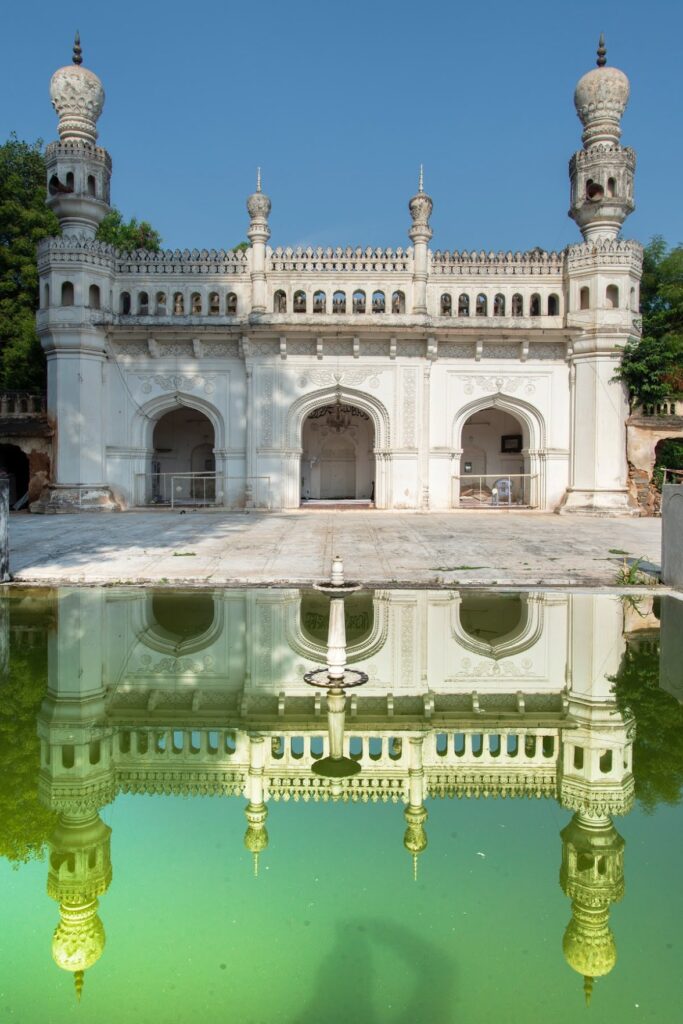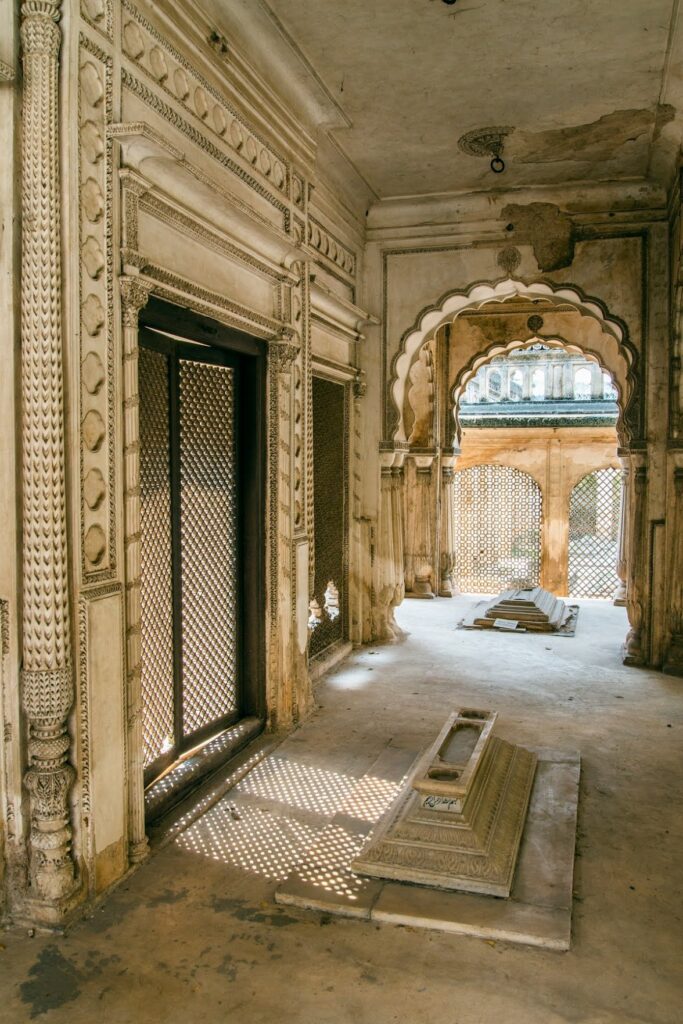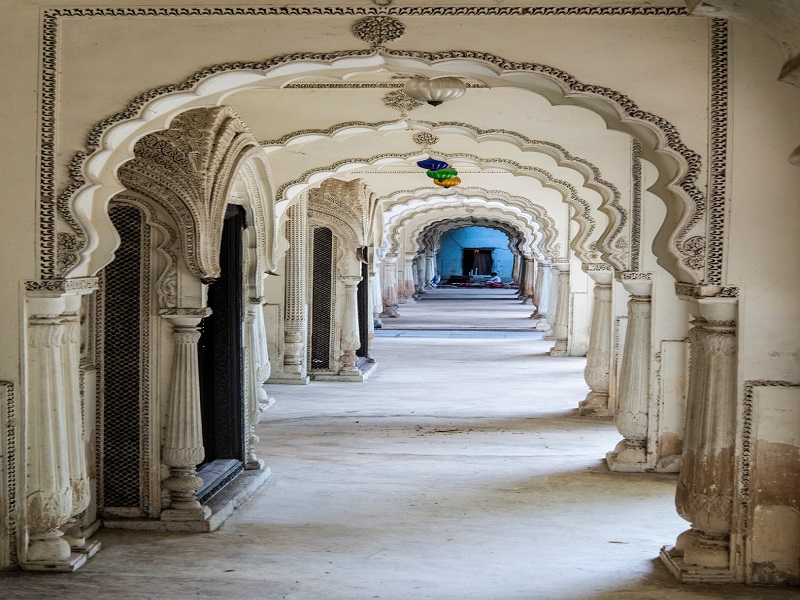Discover the timeless allure of Hyderabad’s Paigah Tombs, a marvel where 18th-century elegance meets a mosaic of 8 architectural styles. From intricate carvings to serene domes, each tomb narrates a rich saga of craftsmanship and heritage. Step into history’s embrace at this extraordinary blend of past and present.
The necropolis, built in 1786, is an amalgamation of eight diverse styles—French, Italian, Greek, Turkish, Mughal, Rajput, Persian and Kakatiyan.
Inside the heart of Hyderabad’s old city lies its best kept secret. Maqhbara Shams ul-Umara, better known as the Paigah Tombs, is an ancient necropolis that is just a 15-minute drive from the world-renowned Charminar, but it remains forgotten by the city with even most locals unaware of its arresting beauty and allure.
Sharing stories of lime and mortar, even in a city full of architectural wonders, the Paigah Tombs stand out because of their sheer magnificence and melange of styles. Fenestrations that are full of detailing, scalloped arches and screened lattices so fine that no two frames are similar make this a little-known gem.
The Paigahs were the most influential aristocrats of the erstwhile princely state of Hyderabad, second only to the Nizams and related to them by marriage. The necropolis came into existence in 1786, with the death of Abul Fateh Khan, a valiant soldier, also known as the “Sun of the Nobles”. The site was chosen because of its proximity to the dargah of the sufi saint Burhane Shah, who came to India from Iraq and was buried in an open enclosure in 1655. Initially spread over 6.5 acres, it has now shrunk to 2 acres due to encroachment.
Faiz Khan Paigah, an eighth-generation descendant of the family, calls the Paigah Tombs a mammoth complex matchless in its design. He adds, “The architecture is unique as it is an amalgamation of eight diverse styles—French, Italian, Greek, Turkish, Mughal, Rajput, Persian and Kakatiyan. No other place in the city boasts of so many influences.”
A Confluence of Design

An arched gateway called “Naubat Khana” leads us into the necropolis. Ornate trellises, intricately carved pillars and embellished domes resembling an onion peek in from every corner. Go on a weekday and all you can hear is the cry of birds drenching the space with poignant beauty.
The Paigahs were renowned patrons of art and at one point, the graves were supposed to be embedded with stones that changed colour according to the time of the day. With over 28 graves, the crypts are soaked in architectural grandeur. Some with marble chowkandis (small pavilions) over the tombs that are decorated with fine engravings, while others boast of stunning pietra dura inlay work on Makrana marble from Rajasthan (used in the construction of the Taj Mahal).
Khan adds, “The tombs of Amir-e-Paigah Sir and Lady Khurshid Jah Hussian-Un-Nissa Begum sahiba are inlaid with precious and semi-precious stones like those made for Mumtaz Mahal and Shah Jahan.”
Significant Style
Architecturally, their significance lies in the fact that the Tombs have amalgamated different styles also due to the fact that they were built over two centuries. Its evidence is present in the intricate jaalis in lime plaster and exquisite stucco carvings, unmatched in the country. Every enclosure has limestone jaalis while carved doors (made from mahogany, teak and rosewood) function as entrances. The mosaic tilework adds another element of ornamentation inside the tombs.
Over 35 different types of jaalis are found in the necropolis, many following the basic six-fold isometric grid. They showcase the Islamic interpretations of the feminine (matter) and masculine (mind) through geometric patterns, including fruits and flowers, serpents, drums and vases as well as the traditional designs of stars and circles. Delicate friezes are carved in complex shapes throughout the tombs: from pineapples (signifying wealth), opulent bouquets of flowers, to arches that seem to merge into the heavens.
Many jaalis however are broken, while entire chunks have disappeared in some, lending them an eerie beauty. They create enticing patterns on the floor as the afternoon sun plays peek-a-boo with these decorative screens.
One highlight, which exemplifies the rich style of the necropolis, is the Ladli Begum Tomb that has lattice screens with a base of one millimetre thick terracotta while using the conventional pattern of 10-fold rosette to achieve a beautiful effect. The uniqueness lies in the construction techniques used to fix the terracotta pieces together to get the geometry of the rosettes and perfect pentagrams within them astoundingly accurate and symmetric.
Conservation Efforts

A US funded conservation project is currently underway with the Aga Khan Trust for Culture (AKTC) leading the efforts. Ratish Nanda, CEO of AKTC calls the Paigah Tombs unique not only for Hyderabad but for the country. “There are no other groups of monuments that are of a similar architectural style. Here, the graves, open to sky—as per orthodox Islamic belief, are enclosed with elaborate screens that are deceptively like grand structures. The profuse ornamentation—stucco plaster, minarets and lattice screens are exceptional—made with terracotta and lime,” he notes.
AKTC has spent years documenting the structures and trying to revive the craft skills required for the conservation works. While the work is expected to take three more years, some of the landscape works have been completed, including granite stone paving.
Nanda states that the restoration of the jaalis, based on the revival of the crafts skills will be the absolute highlight of the conservation effort. He adds, “The incredible jaalis at Paigah Tombs are unique; such lattice screens based on terracotta base and covered with lime are not seen anywhere.”
The premises also are home to a small mosque, water body and wrought iron benches. The ancient mango and badam trees, a heady mixture of architecture styles and the lingering beauty of the necropolis, make it an Instagrammer’s delight. Little wonder then that the caretaker, Rahmatullah, calls these tombs, “The Taj of the South.” #hydkhabar

